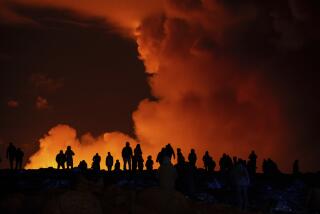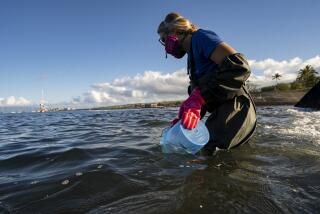As lava pours into the ocean from Hawaii’s Kilauea, a new risk surfaces: laze

Since the Hawaiian volcano Kilauea began erupting this month, residents on the Big Island have endured a lot — toxic gas, earthquakes and plumes of ash. Nearly 2,000 people have been evacuated, and lava flows have gobbled up dozens of homes in the lower Puna area of the island.
Then over the weekend, rivers of lava crossed a highway and entered the ocean, creating a new hazard known as laze.
Island residents are familiar with vog, or volcanic smog, which is formed when sulfur dioxide is emitted from erupting lava. It’s a health hazard if you have respiratory problems and live near an eruptive vent, and Kilauea is producing a lot of it.
Here’s a primer on its cousin laze, or lava haze.
What is it?
When the lava flow goes into the ocean water, it boils the water and creates a white acidic plume. That’s laze.
“It’s a complex chemical reaction that occurs between the lava flow and seawater,” said Wendy Stovall, a volcanologist with the U.S. Geological Survey. “It creates a mixture of condensed acidic steam, hydrochloric acid gas and tiny shards of volcanic glass.”
From the air, the plume looks like exhaust from a factory or the white smoke released during a forest fire.
How dangerous is it?
When lava hits the ocean, it can heat the water to temperatures capable of causing third-degree burns.
If you’re underneath the plume, a light sprinkle of rain as corrosive as battery acid can fall on you. The acid can burn your skin, irritate your eyes and make it difficult to breathe. In rare cases, the damage can be permanent.
Or fatal. Two tourists died in 2000 when they were “apparently scalded by acid-laced steam,” the USGS said.
There have been no reports of injuries as a result of the laze created in this month’s series of eruptions.
How close can you get to it without being in danger?
That depends on the concentration of acid, the size of the plume and the wind.
“The greater distance, the safer the person would be,” said Dr. Alvin Bronstein of the Hawaii Department of Health. “Being near where the lava is entering the sea would not be advised.”
Stovall said to keep a safe distance, but she didn’t specify what that is.
When lava flows into the ocean, it can create secondary blasts called littoral explosions.
“They’re beautiful to watch, but the hazards are very real. Hot lava particles can be thrown hundreds of yards from the ocean entry site during these littoral explosions,” Stovall said.
The plume travels with the wind and can change direction without warning.
“You don’t want to interact with the laze plume,” Stovall said. “You don’t want to be in a boat beneath the plume, and on the ground if the plume is blowing your way, or in that plume.”
Janet Babb, a Hawaiian Volcano Observatory geologist, said she wasn’t aware of past situations in which laze caused widespread public health problems. But she cautioned: “If you are downwind, then you will be affected by the laze.”
There are freak dangers associated with laze. In 1994, two people standing near a spot where lava was entering the ocean were scalded so severely by a wave that they had to be hospitalized, according to the USGS.
How scary is laze ?
That’s debatable.
“I’ve never gotten close enough to see how scary it is,” Stovall said. “I’ve followed my own advice.”
How long will the eruptions continue to produce laze?
“As long as lava is flowing into the ocean, there will be a laze plume,” Stovall said.
Kilauea has been erupting consistenly since 1983, and laze has been a periodic problem.
“Laze plumes occurred each time lava flows reached and flowed into the ocean during the entire 35 years,” she said.
Is there a way to watch it now?
Two lava flows are entering the ocean at Pohoiki near Malama Flats, northeast of MacKenzie Recreation Area and southwest of Isaac Hale Beach Park.
The lava flows going into the ocean are bigger than they’ve been in three decades, said Mike Poland, a geophysicist with the USGS. “It’s molten rock,” he said. “It’s amazing. It’s a stunning sight to see.”
One park ranger put it this way: “It’s a chance in a lifetime to view the creation of earth. Where else in the world can you approach it so intimately?”
But access to the area is prohibited because of laze.
It may be possible to see the flows from a tour boat. But the U.S. Coast Guard is enforcing a “standoff zone” of about 330 yards.
The coastline where the lava is entering the ocean is not part of Hawaii Volcanoes National Park, where Kilauea is located.
Most of the park, the most visited attraction in the state, has been closed for nearly two weeks.
Images on the news are the safest way to see the eruption and its various effects.
Are there any other current dangers?
One man was injured while standing on his third-floor balcony when he was hit in the shin by a piece of lava — known as a lava bomb or a spatter bomb.
He was way too close, Stovall said.
Other risks include methane explosions and fires. “When lava is flowing over new land and vegetation, it can produce fires that can spread quickly, methane explosions that can throw blocks of lava rock,” Stovall said.
Her advice: “Don’t get close to the active lava.”

Times staff writer Rong-Gong Lin II contributed to this report.
More to Read
Start your day right
Sign up for Essential California for news, features and recommendations from the L.A. Times and beyond in your inbox six days a week.
You may occasionally receive promotional content from the Los Angeles Times.






